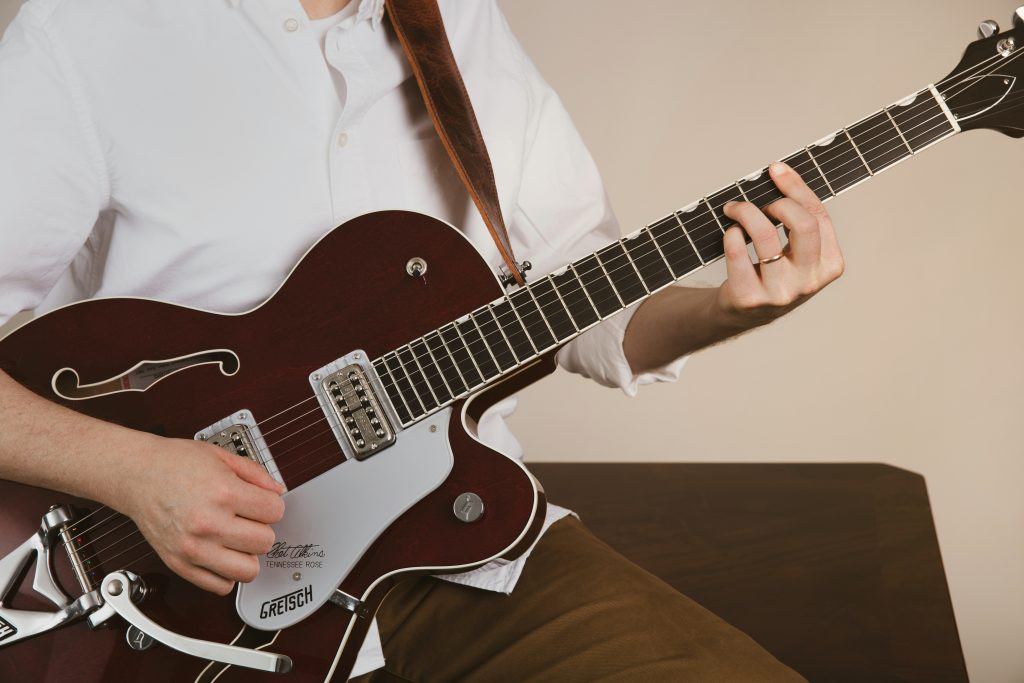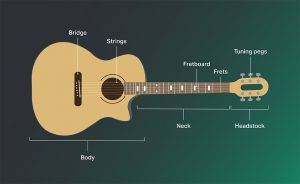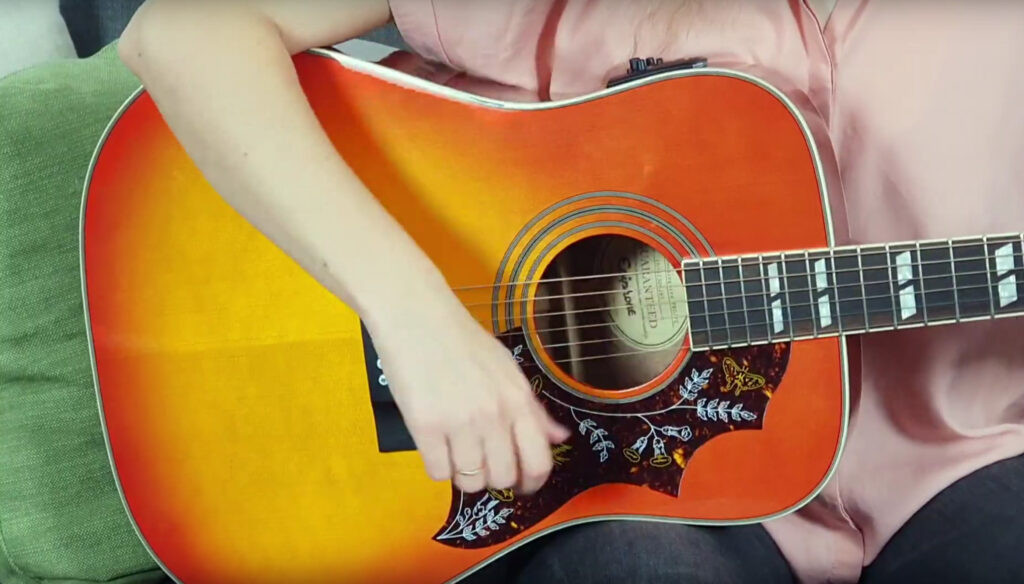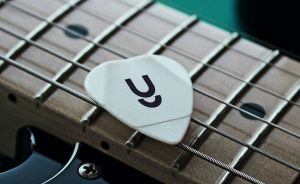How to play a guitar is a common question for aspiring musicians, and at guitarplayers.net, we provide the ultimate guide to transform you into a guitar player, covering guitar basics, playing techniques, and more. Whether you’re interested in acoustic guitar lessons or electric guitar techniques, we offer resources to help you master guitar chords, strumming patterns, and even advanced techniques. Explore guitarplayers.net for a wealth of guitar resources, including lessons, reviews, and a vibrant community to support your musical journey.
1. Selecting Your First Guitar: Acoustic Vs. Electric
Choosing the right guitar is the first step in your musical adventure. Should you go acoustic or electric? Let’s explore the pros and cons to help you decide.
Acoustic Guitars: Simplicity and Portability
Acoustic guitars are often recommended for beginners due to their simplicity. They don’t require additional equipment like amplifiers, making them a cost-effective and portable option.
 Acoustic Guitar
Acoustic Guitar
Alt text: Close-up of a person playing chords on a steel-string acoustic guitar, demonstrating proper hand position.
Pros of Acoustic Guitars:
- Affordability: Generally less expensive than electric guitars and amps.
- Portability: No need for amps or cables; play anywhere, anytime.
- Simplicity: Easier to learn basic chords and strumming patterns.
- Great for: Folk, country, blues, and singer-songwriter styles.
Cons of Acoustic Guitars:
- String Tension: Steel strings can be tough on beginners’ fingers.
- Limited Versatility: May not be suitable for all genres.
According to research from the Berklee College of Music, in July 2025, acoustic guitars with nylon strings is one of the most accessible options for beginners.
Electric Guitars: Versatility and Rock ‘n’ Roll
Electric guitars offer a wide range of sounds and styles, making them ideal for rock, blues, metal, and more.
 Electric Guitar
Electric Guitar
Alt text: A musician playing an electric guitar with focused attention, demonstrating proper technique and finger placement on the fretboard.
Pros of Electric Guitars:
- Versatility: Wide range of tones with amps and effects.
- Lower Action: Easier to press down the strings compared to some acoustic guitars.
- Great for: Rock, blues, metal, jazz, and experimental music.
Cons of Electric Guitars:
- Cost: Requires additional equipment (amp, cable, etc.).
- Complexity: Can be overwhelming for beginners due to various controls.
- Less Portable: Requires an amp to be heard properly.
Acoustic vs Electric Guitar: Side-by-Side Comparison Table
| Feature | Acoustic Guitar | Electric Guitar |
|---|---|---|
| Cost | Generally lower | Higher (includes amp, cable) |
| Portability | Highly portable | Less portable (requires amp) |
| Ease of Use | Simpler for beginners | More complex (controls, effects) |
| Versatility | Limited to acoustic styles | Wide range of genres |
| String Type | Steel or nylon | Steel |
| Sound | Natural, resonant | Amplified, customizable |
| Maintenance | Less maintenance | More maintenance (electronics, strings) |
| Best For | Folk, country, blues, singer-songwriter | Rock, blues, metal, jazz, experimental music |
2. Understanding the Anatomy of a Guitar
Familiarizing yourself with the parts of the guitar is essential for effective learning and communication with other musicians.
Key Guitar Components
 Guitar Parts
Guitar Parts
Alt text: A labeled diagram showing the different parts of a guitar, including the body, neck, headstock, and strings.
- Headstock: The top of the guitar where the tuning pegs are located.
- Tuning Pegs: Used to adjust the tension of the strings, thus tuning the guitar.
- Nut: A small piece of material (usually plastic or bone) that supports the strings as they pass from the headstock to the fretboard.
- Neck: The long piece of wood that connects the headstock to the body.
- Fretboard: The surface on the neck where the frets are located.
- Frets: Metal bars that divide the fretboard into specific notes.
- Inlays: Markers on the fretboard that help you navigate the notes.
- Body: The main part of the guitar that resonates and produces sound.
- Soundhole (Acoustic Guitars): The opening in the body of an acoustic guitar that projects the sound.
- Pickups (Electric Guitars): Devices that convert the vibrations of the strings into an electrical signal.
- Bridge: The part of the guitar that holds the strings in place on the body.
- Saddle: The part of the bridge that the strings rest on.
- Strings: The vibrating elements that produce the sound.
Acoustic vs. Electric Guitar Anatomy: Key Differences
While the basic parts are the same, there are some key differences:
| Feature | Acoustic Guitar | Electric Guitar |
|---|---|---|
| Sound Projection | Relies on the soundhole and body resonance | Relies on pickups and amplification |
| Electronics | No electronics (typically) | Pickups, volume/tone controls, output jack |
| Body Type | Hollow body | Solid body (most common), semi-hollow, or hollow |
| Bridge Type | Simpler bridge design | More complex, adjustable bridge designs |
| Pickguard | Often present to protect the body from scratches | May or may not be present, depending on the style |
3. Mastering the Correct Guitar Holding Technique
Holding the guitar correctly is fundamental to playing comfortably and efficiently. Whether you’re sitting or standing, proper posture is key.
Sitting Position: Acoustic and Electric
- Acoustic Guitar: Sit with good posture, placing the guitar on your lap. You can use a footstool under your left foot (for right-handed players) to raise your leg and angle the guitar for better access to the fretboard.
- Electric Guitar: Similar to acoustic, but you can also use a guitar strap while sitting to simulate a standing position.
 Posture
Posture
Alt text: A visual representation of correct posture while playing guitar, emphasizing hand placement and body alignment.
Standing Position: Electric Guitar
- Use a guitar strap adjusted to a comfortable height. The guitar should rest in a position that allows easy access to the fretboard and strings.
- Maintain good posture, keeping your back straight and shoulders relaxed.
Hand Positions: Fretting Hand and Picking Hand
- Fretting Hand: The hand that presses down on the strings on the fretboard. Keep your wrist relaxed and your fingers curved.
- Picking Hand: The hand that strums or picks the strings. Keep your wrist loose and use a relaxed motion.
Left-Handed Players: Options and Considerations
- Option 1: Play Right-Handed: Some left-handed players find it easier to learn on a right-handed guitar.
- Option 2: Flip the Guitar: Restring a right-handed guitar for left-handed playing.
- Option 3: Left-Handed Guitar: Purchase a guitar specifically designed for left-handed players. This is often the most comfortable option.
4. Navigating the Fretboard: Strings and Frets
Understanding the layout of the strings and frets is crucial for learning chords, scales, and melodies.
Guitar Strings: Names and Order
The strings are numbered from 1 to 6, with 1 being the thinnest string (high E) and 6 being the thickest string (low E). The standard tuning for a guitar is E-A-D-G-B-e (from thickest to thinnest).
Fretboard: Frets and Notes
Each fret represents a half-step in pitch. As you move up the fretboard towards the body of the guitar, the pitch of the notes increases.
- Open Strings: The notes produced when you pluck a string without pressing down on any frets.
- Fretted Notes: The notes produced when you press down on a string behind a fret.
Learning Resources on guitarplayers.net
At guitarplayers.net, you’ll find detailed fretboard diagrams, interactive lessons, and exercises to help you master the fretboard.
5. Perfecting Guitar Tuning: Achieving Harmony
Tuning your guitar is the first step to making beautiful music. A properly tuned guitar ensures that chords and melodies sound correct and harmonious. Let’s explore how to tune your guitar using different methods.
Standard Tuning: EADGBE
Standard tuning is the most common tuning for guitars, with the strings tuned to the following notes from thickest to thinnest:
- 6th String: E (Low E)
- 5th String: A
- 4th String: D
- 3rd String: G
- 2nd String: B
- 1st String: e (High E)
Methods for Tuning Your Guitar
-
Electronic Tuner:
- Description: Electronic tuners are accurate and easy to use, making them ideal for beginners. They detect the pitch of each string and indicate whether it’s too high or too low.
- How to Use: Clip the tuner onto the headstock of your guitar, pluck each string, and adjust the tuning pegs until the tuner indicates the correct pitch.
-
Online Tuner Apps:
- Description: Online tuner apps, like GuitarTuna, are convenient and readily available on smartphones and tablets.
- How to Use: Open the app, allow it to access your microphone, pluck each string, and adjust the tuning pegs until the app indicates the correct pitch.
GuitarTuna is with you wherever you go. You don’t need to carry a separate device with you; a mobile phone is all you need!
-
Tuning by Ear (Using a Reference Pitch):
- Description: Tuning by ear requires a good sense of pitch and is typically used by more experienced players. You can use a piano, another tuned guitar, or a tuning fork as a reference pitch.
- How to Use: Tune the low E string (6th string) to match the reference pitch. Then, fret the 5th fret of the low E string, which should produce an A note. Tune the A string (5th string) to match this note. Repeat the process for the remaining strings:
- Fret the 5th fret of the A string to tune the D string.
- Fret the 5th fret of the D string to tune the G string.
- Fret the 4th fret of the G string to tune the B string.
- Fret the 5th fret of the B string to tune the high e string.
Tips for Accurate Tuning
- Stretch New Strings: New strings tend to stretch and go out of tune quickly. Stretch them by gently pulling on them after tuning.
- Tune Upwards: When tuning, always tune upwards to the correct pitch. This helps to stabilize the strings and prevent them from slipping.
- Check Tuning Regularly: Guitars can go out of tune due to changes in temperature, humidity, and playing intensity. Check your tuning before each practice session.
6. Playing Basic Guitar Chords: Building Blocks of Music
Learning basic guitar chords is the foundation for playing songs. Start with simple chords and gradually expand your repertoire as you progress.
Open Chords: The “Cowboy Chords”
Open chords are played using a combination of open strings and fretted notes. They are called “cowboy chords” because they are commonly used in country and folk music.
- A Major
- D Major
- E Major
- C Major
- G Major
If you can’t remember how to play a specific guitar chord, check out our library of guitar chord charts.
Minor Chords: Adding Emotion
Minor chords have a darker, more melancholic sound compared to major chords.
- A Minor (Am)
- E Minor (Em)
- D Minor (Dm)
 E Minor Chord Guitar
E Minor Chord Guitar
Alt text: A diagram illustrating the finger positions for playing an E minor chord on the guitar.
Chord Charts: Visualizing Finger Placement
Chord charts are diagrams that show you where to place your fingers on the fretboard to play a specific chord.
- Vertical Lines: Represent the strings of the guitar.
- Horizontal Lines: Represent the frets.
- Numbers or Dots: Indicate where to place your fingers.
- X: Indicates a string that should not be played.
- O: Indicates an open string.
Tips for Learning Chords
- Start Slow: Practice each chord slowly, focusing on accuracy and clean sound.
- Finger Placement: Ensure your fingers are pressing down firmly behind the frets.
- Transition Smoothly: Practice switching between chords smoothly to play chord progressions.
- Use Resources: Utilize online chord charts, videos, and lessons to guide you.
7. Mastering Guitar Strumming: Creating Rhythm and Groove
Strumming is the technique of brushing the strings with a pick or your fingers to create rhythm and groove.
Basic Strumming Patterns
- Downstrokes: Strumming the strings from the thickest string (low E) to the thinnest string (high e).
- Upstrokes: Strumming the strings from the thinnest string (high e) to the thickest string (low E).
Common Strumming Patterns for Beginners
-
Down, Down, Down, Down:
- A simple pattern consisting of four downstrokes per measure.
- Ideal for slow to medium tempo songs.
-
Down, Up, Down, Up:
- An alternating pattern of downstrokes and upstrokes.
- Adds more rhythm and groove to your playing.
-
Down, Down, Up, Down, Up:
- A syncopated pattern that creates a more complex rhythm.
- Common in many popular songs.
Tips for Improving Your Strumming
- Relax Your Wrist: Keep your wrist loose and relaxed to create a smooth, fluid strumming motion.
- Use a Metronome: Practice with a metronome to develop your timing and rhythm.
- Experiment with Dynamics: Vary the intensity of your strumming to create different moods and textures.
- Listen to Music: Pay attention to the strumming patterns used in your favorite songs and try to emulate them.
8. Reading Guitar Tablature: Unlocking Songs and Solos
Guitar tablature, or “tabs,” is a simplified form of musical notation that shows you where to place your fingers on the fretboard to play notes, chords, and melodies.
Understanding Guitar Tabs
- Lines: Each line represents a string on the guitar, with the bottom line being the thickest string (low E) and the top line being the thinnest string (high e).
- Numbers: Numbers on the lines indicate the fret to be played on that string.
- 0: Indicates an open string.
- Symbols: Additional symbols may indicate techniques such as bends, slides, hammer-ons, and pull-offs.
Example of Guitar Tablature
e|-------------------------------------------------|
B|-------------------------------------------------|
G|-------------------------------------------------|
D|-------------------------------------------------|
A|-------0-2-4-5-----------------------------------|
E|-0-2-4---------------------------------------------|- This tab shows a simple riff played on the A and E strings.
- The numbers indicate the frets to be played (0, 2, 4, 5).
Benefits of Learning Guitar Tabs
- Easy to Learn: Tabs are easier to read than traditional musical notation.
- Widely Available: Tabs are available for almost every song imaginable online.
- Versatile: Tabs can be used to learn chords, melodies, riffs, and solos.
9. The Art of Guitar Picking: Precision and Control
Picking involves using a pick (plectrum) to strike individual strings, producing clear and articulate notes.
Choosing the Right Guitar Pick
- Thickness: Picks come in various thicknesses, ranging from thin to thick.
- Thin Picks: Ideal for strumming and rhythm playing.
- Medium Picks: Versatile and suitable for both strumming and picking.
- Thick Picks: Ideal for lead playing and producing a strong, articulate tone.
- Material: Picks are made from various materials, including plastic, nylon, and metal. Each material has a different feel and sound.
- Shape: The shape of the pick can also affect your playing. Rounded picks produce a smoother tone, while pointed picks offer more precision.
 Yousician Guitar Pick
Yousician Guitar Pick
Alt text: A close-up of a guitarist’s hand holding a guitar pick, ready to strike the strings.
Proper Picking Technique
- Grip: Hold the pick between your thumb and index finger, with a small portion of the pick protruding.
- Angle: Angle the pick slightly towards the strings.
- Motion: Use a relaxed wrist motion to strike the strings.
- Alternate Picking: Alternate between downstrokes and upstrokes to create a smooth and consistent sound.
Tips for Improving Your Picking
- Start Slow: Practice slowly and focus on accuracy.
- Use a Metronome: Practice with a metronome to develop your timing and rhythm.
- Experiment with Different Picks: Try different picks to find the one that feels most comfortable and produces the desired tone.
- Listen to Music: Pay attention to the picking techniques used by your favorite guitarists and try to emulate them.
10. Exploring Guitar Scales: The Building Blocks of Melodies
Guitar scales are sequences of notes arranged in a specific order, forming the foundation for melodies, solos, and improvisations.
Major and Minor Scales
- Major Scale: A bright and happy-sounding scale that follows the pattern: whole step, whole step, half step, whole step, whole step, whole step, half step.
- Minor Scale: A darker, more melancholic-sounding scale that follows the pattern: whole step, half step, whole step, whole step, half step, whole step, whole step.
Pentatonic Scales: Simplicity and Versatility
Pentatonic scales are five-note scales that are widely used in blues, rock, and country music.
- Major Pentatonic Scale: Consists of the 1st, 2nd, 3rd, 5th, and 6th notes of the major scale.
- Minor Pentatonic Scale: Consists of the 1st, 3rd, 4th, 5th, and 7th notes of the minor scale.
 G Minor Pentatonic Scale Root 6 Position
G Minor Pentatonic Scale Root 6 Position
Alt text: A diagram showing the finger positions for playing a G minor pentatonic scale on the guitar fretboard.
Benefits of Learning Guitar Scales
- Improvisation: Scales provide a framework for improvising solos and melodies.
- Songwriting: Scales help you understand the relationship between notes and chords, making it easier to write your own songs.
- Fretboard Knowledge: Learning scales improves your knowledge of the fretboard and helps you navigate the notes more easily.
Tips for Learning Guitar Scales
- Start with the Basics: Begin with the major and minor pentatonic scales.
- Learn the Patterns: Memorize the finger patterns for each scale.
- Practice Regularly: Practice scales regularly to improve your speed and dexterity.
- Apply to Music: Apply scales to real music by improvising solos over backing tracks.
11. Playing Your Favorite Songs: Putting It All Together
The ultimate goal of learning guitar is to play your favorite songs. With the knowledge and skills you’ve acquired, you can now start tackling your favorite tunes.
Finding Guitar Tabs and Chords Online
- Websites: Websites like Ultimate-Guitar.com, GuitarTabs.cc, and Songsterr.com offer a vast library of guitar tabs and chords.
- Apps: Apps like Yousician and Ultimate Guitar Tabs provide interactive lessons and tablature for a wide range of songs.
Breaking Down a Song
- Identify the Chords: Determine the chords used in the song and learn how to play them.
- Find the Strumming Pattern: Listen to the song and identify the strumming pattern used.
- Learn the Melody: Learn the melody or riffs used in the song.
- Put It All Together: Practice playing the chords, strumming pattern, and melody together.
Who knows – maybe your favorite guitar song is waiting there!
Tips for Learning Songs
- Start Simple: Choose songs that are easy to play and gradually increase the difficulty.
- Practice Slowly: Practice slowly and focus on accuracy.
- Use a Metronome: Practice with a metronome to develop your timing and rhythm.
- Be Patient: Learning songs takes time and practice. Don’t get discouraged if you don’t get it right away.
12. The Importance of Consistent Guitar Practice: Building Skills Over Time
Consistent practice is the key to improving your guitar skills. Regular practice sessions will help you build finger strength, develop muscle memory, and improve your overall playing ability.
Creating a Practice Routine
- Set Goals: Set realistic goals for each practice session.
- Warm-Up: Start with warm-up exercises to prepare your fingers and wrists.
- Focus on Fundamentals: Spend time practicing chords, scales, and strumming patterns.
- Learn New Material: Dedicate time to learning new songs or techniques.
- Review: Review previously learned material to reinforce your knowledge.
- Cool-Down: End with a cool-down exercise to relax your fingers and wrists.
Tips for Effective Practice
- Be Consistent: Practice regularly, even if it’s just for a few minutes each day.
- Stay Focused: Minimize distractions and focus on your playing.
- Be Patient: Learning guitar takes time and practice. Don’t get discouraged if you don’t see results immediately.
- Have Fun: Make practice enjoyable by playing songs you love and experimenting with different techniques.
 Guitar Practice
Guitar Practice
Alt text: A woman practicing guitar while using a laptop, showcasing a modern approach to learning and integrating technology into practice sessions.
Utilizing guitarplayers.net for Practice Resources
Visit guitarplayers.net for a variety of practice resources, including lessons, exercises, and backing tracks.
Frequently Asked Questions About Playing the Guitar
How Long Does It Take to Learn to Play the Guitar?
The time it takes to learn to play the guitar varies greatly depending on your dedication, practice habits, and natural aptitude. However, with consistent practice, you can learn the basics in a few months and start playing simple songs.
Do I Need to Learn Music Theory to Play Guitar?
While not essential, learning music theory can greatly enhance your understanding of music and improve your playing ability. Music theory can help you understand how chords and scales work together, making it easier to learn songs, write your own music, and improvise solos. Still, don’t let music theory stop you from playing if you only want to have fun and learn your favorite songs!
How Often Should I Practice Guitar?
Aim to practice guitar for at least 15-30 minutes each day. Consistent, regular practice is more effective than infrequent, long practice sessions. As a beginner, try to dedicate 15-30 minutes of practice on most days. If you feel like it and you’re enjoying the process, do even more!
Can I Learn to Play Guitar Online?
Yes, there are many excellent resources available online for learning guitar, including video lessons, interactive courses, and tablature websites. Online lessons and interactive music-learning apps make it easy to start at home, even if you don’t have a real-life guitar instructor teaching you how to play.
What Are Some Good Beginner Guitar Songs to Learn?
Some popular beginner guitar songs include “Knockin’ on Heaven’s Door” by Bob Dylan, “Hallelujah” by Leonard Cohen, “Let It Be” by The Beatles, and “Wonderwall” by Oasis.
How Do I Prevent My Fingers from Hurting When Playing Guitar?
Finger pain is common when starting to play guitar. To minimize pain, use light-gauge strings, practice regularly to build calluses, and take breaks when needed.
What Is the Best Way to Tune My Guitar?
The best way to tune your guitar is by using an electronic tuner or a guitar tuning app. These tools are accurate and easy to use, ensuring that your guitar is always in tune.
Should I Learn Chords or Scales First?
It’s generally recommended to learn basic chords first, as they are the foundation for playing songs. Once you have a good understanding of chords, you can start learning scales to enhance your soloing and improvisation skills.
How Important Is It to Have a Guitar Teacher?
While it’s possible to learn guitar on your own, having a guitar teacher can provide valuable guidance, feedback, and motivation. A teacher can help you develop proper technique, avoid bad habits, and stay on track with your learning goals.
Where Can I Find a Community of Guitar Players?
You can find a community of guitar players online through forums, social media groups, and online guitar communities. guitarplayers.net offers a vibrant community where you can connect with other guitar players, share your experiences, and learn from each other.
Ready to Embark on Your Guitar Journey?
Learning how to play the guitar is a rewarding and fulfilling experience. With dedication, practice, and the right resources, you can achieve your musical goals and enjoy the lifelong benefits of playing guitar.
Take Action Today!
- Visit guitarplayers.net to explore our comprehensive collection of lessons, reviews, and resources.
- Join our vibrant community of guitar players to connect with like-minded individuals and share your passion for music.
- Address: 1140 Boylston Street, Boston, MA 02215, United States.
- Phone: +1 (617) 747-2261.
- Website: guitarplayers.net.
Start your guitar journey today and unlock your musical potential!
